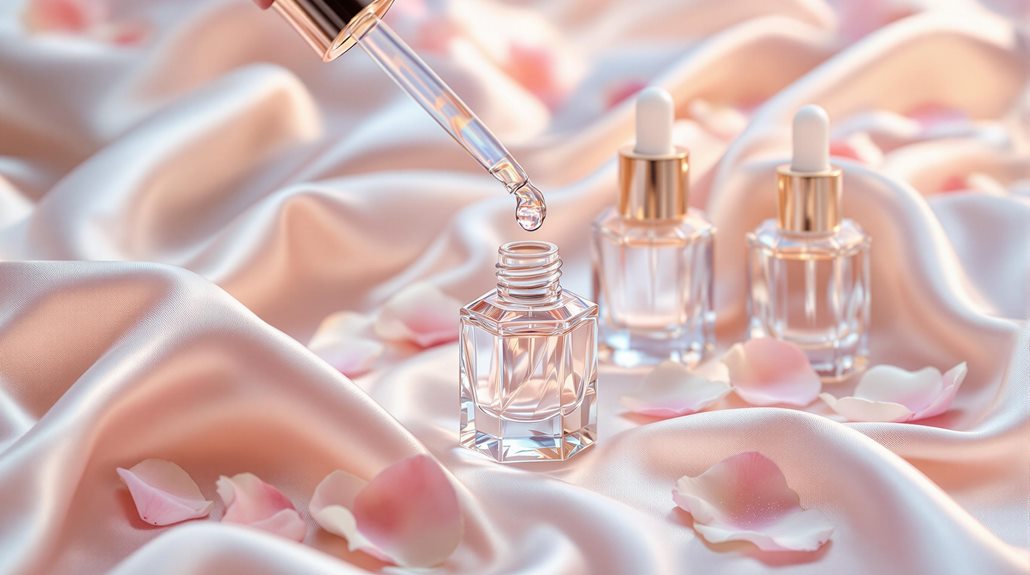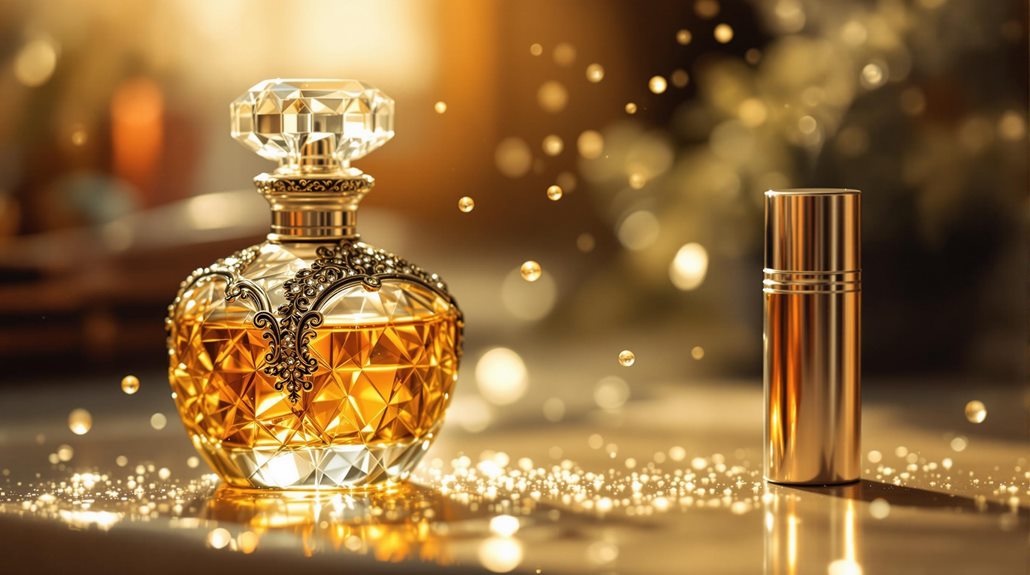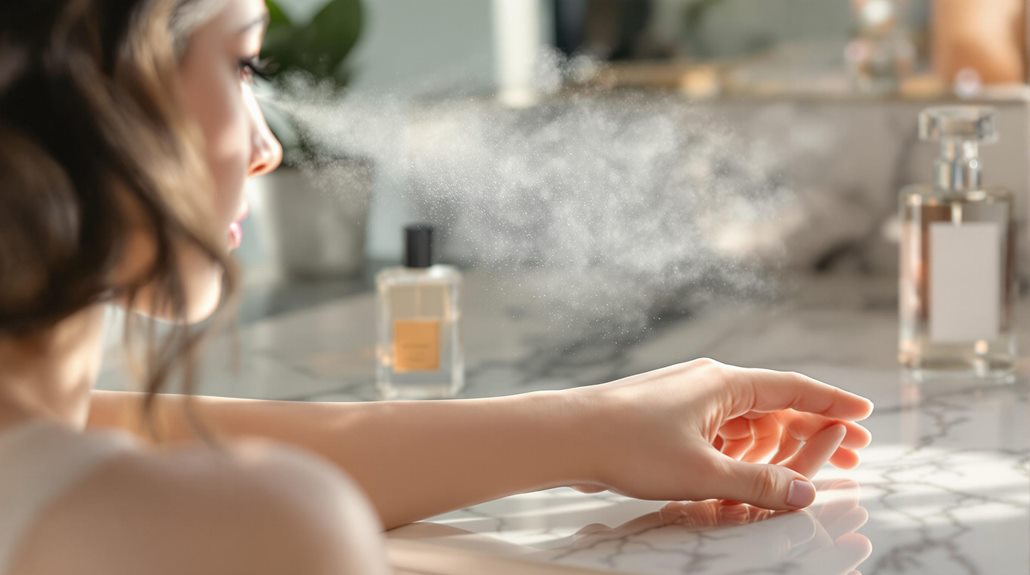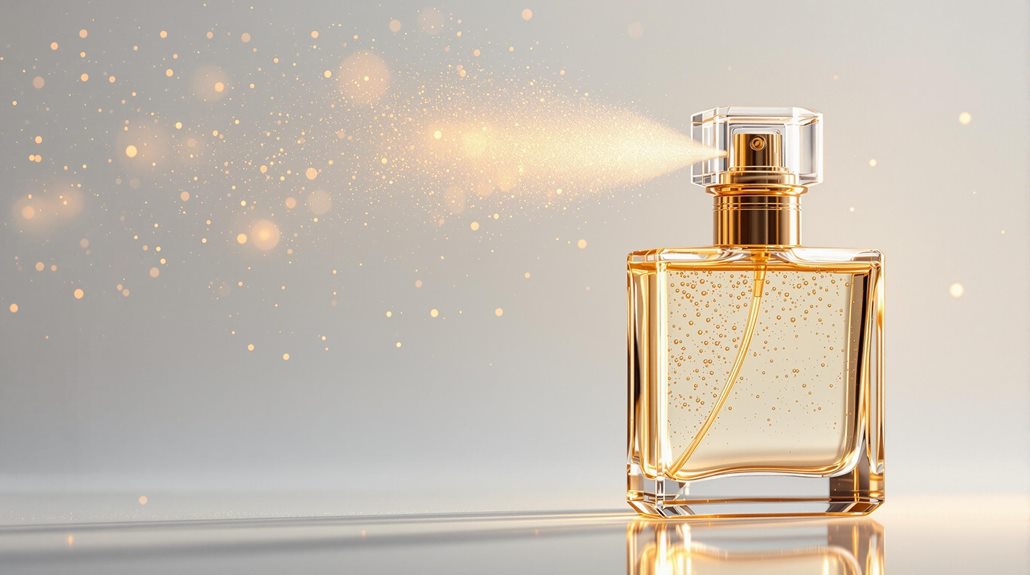A Beginner's Guide to Making Natural Perfume at Home
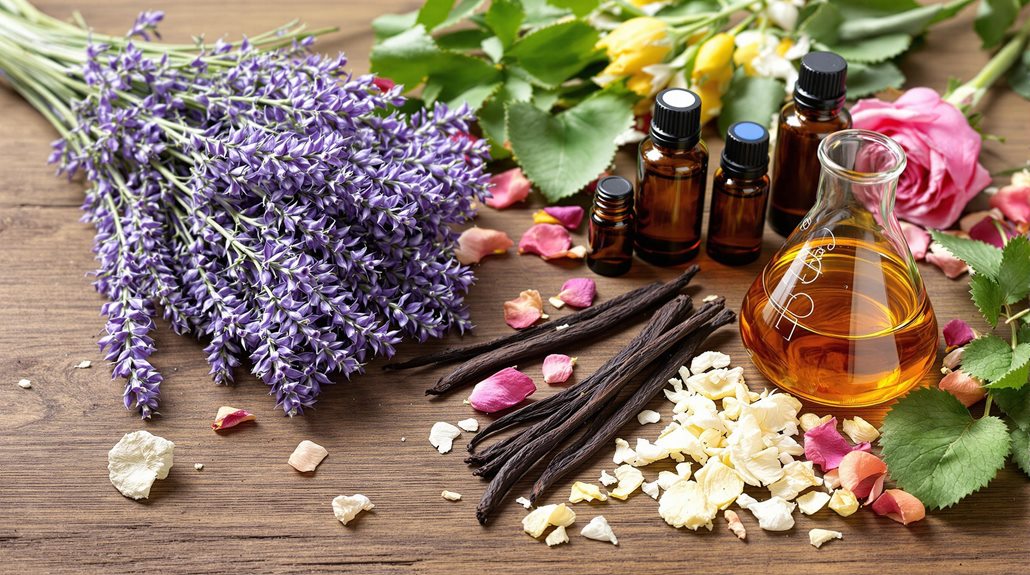
Making natural perfume at home starts with gathering essential tools like glass containers, pipettes, and measuring spoons. You'll need essential oils for fragrance, carrier oils for dilution, and beeswax as a natural fixative. Begin by selecting complementary scent notes - top notes for initial impression, middle notes for the heart, and base notes for lasting power. Combine your chosen oils with a carrier in a 4:1 ratio, and store your creation in dark glass bottles with tight-fitting caps. While simple blends work well for beginners, understanding how different scent families interact will open up endless creative possibilities.
Understanding Natural Perfume Ingredients
Behind every alluring natural perfume lies a carefully selected blend of key ingredients that work together in harmony. When you're creating your own natural fragrance, you'll need to understand these four fundamental components that make up your perfume's composition.
Essential oils form the heart of natural perfumery, providing concentrated aromatic substances extracted directly from plants and flowers. You'll find these oils deliver the primary scent characteristics of your perfume. Working alongside essential oils, aromatic compounds add depth and complexity to your creation, whether they're naturally derived or synthetic alternatives that complement your formula.
To guarantee your perfume's scent lasts longer, you'll need fixatives. These non-volatile materials help anchor the more fleeting fragrances, preventing them from evaporating too quickly. Think of them as the foundation that holds your perfume together. Finally, you'll require solvents, typically alcohol-based, which dissolve and carry all other ingredients. They're essential for achieving the right consistency and helping the fragrance distribute evenly when applied. Understanding how these components interact will help you create a well-balanced, long-lasting natural perfume.
Essential Tools and Equipment
Getting started with natural perfume making requires a well-equipped workspace with specific tools for precise measurements and safe handling. To make your own perfume at home, you'll need several essential items that guarantee accuracy and safety throughout the process.
Start by gathering a collection of glass containers. You'll need various sizes of bottles to store your finished perfume, along with beakers for mixing your ingredients. Precision is indispensable when working with oil based perfumes, so stock up on pipettes that allow you to measure and transfer small amounts of fragrance ingredients accurately. Don't forget to include measuring spoons in your toolkit, as they're essential for following recipes precisely.
If you plan to make solid perfumes, you'll need a hot plate to safely melt ingredients like beeswax. This equipment allows you to control temperature precisely while blending your fragrances. Remember that quality tools directly impact your success - invest in durable glassware and reliable measuring instruments. By having the right equipment on hand, you'll be well-prepared to create your natural perfumes safely and effectively, avoiding common mistakes that could affect your final product.
Choosing Your Fragrance Notes
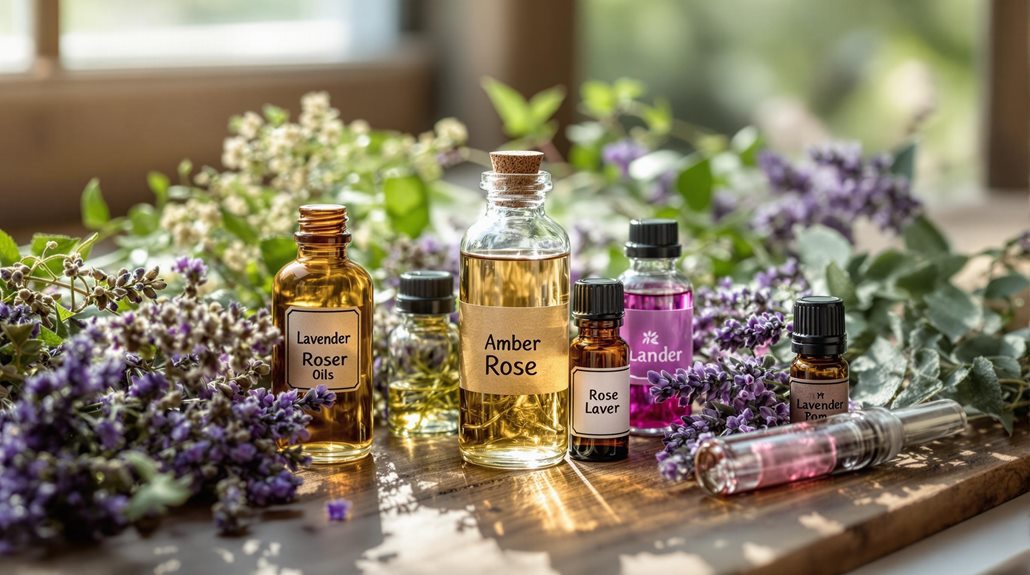
Artistry in natural perfumery begins with understanding fragrance notes and how they work together to create a balanced composition. When you're working with natural ingredients, you'll need to use three distinct categories of fragrance notes to achieve a well-rounded scent that evolves beautifully on the skin.
Start by selecting your top notes, which will create the initial impression of your perfume. You can use citrus oils like bergamot or lemon, or fresh herbal essences like mint or lavender. Next, choose your middle notes, which will form the heart of your fragrance. These could include floral oils like rose or jasmine, or warm spices like cardamom. Finally, select your base notes, which you'll need to use sparingly as they anchor your creation. Woods, resins, and natural musks work well here.
Remember to blend your chosen notes with a carrier oil to fabricate a wearable perfume. The key is maintaining proper proportions: use more top notes, a moderate amount of middle notes, and fewer base notes. This structure generates your natural perfume will develop complexity and lasting power throughout the day.
Oil Infusion Methods
Once you've selected your fragrance notes, the next step is perfecting oil infusion techniques to extract natural scents from your chosen materials. Creating natural perfumes through oil infusion takes a bit of time, but the results are worth the effort. Whether you're working with clary sage or other aromatic botanicals, there are several reliable methods to create your oil based perfume.
- Use a crockpot or saucepan to simmer your dried herbs and flowers in oil until they become dry and crunchy
- Strain the plant material and repeat the process if you want a stronger scent
- Mix your infused oil with grated beeswax using a 4:1 ratio (oil to wax)
- Pour your mixture into small containers like mint tins or baby food jars
- Speed up the hardening process by placing containers in the freezer
You can also try alternative infusion methods, such as placing your herbs and oil in a sunny spot for a gentler extraction process. For those interested in a more advanced approach, using an essential oil still can help you distill your own concentrated fragrances at home.
Working With Beeswax
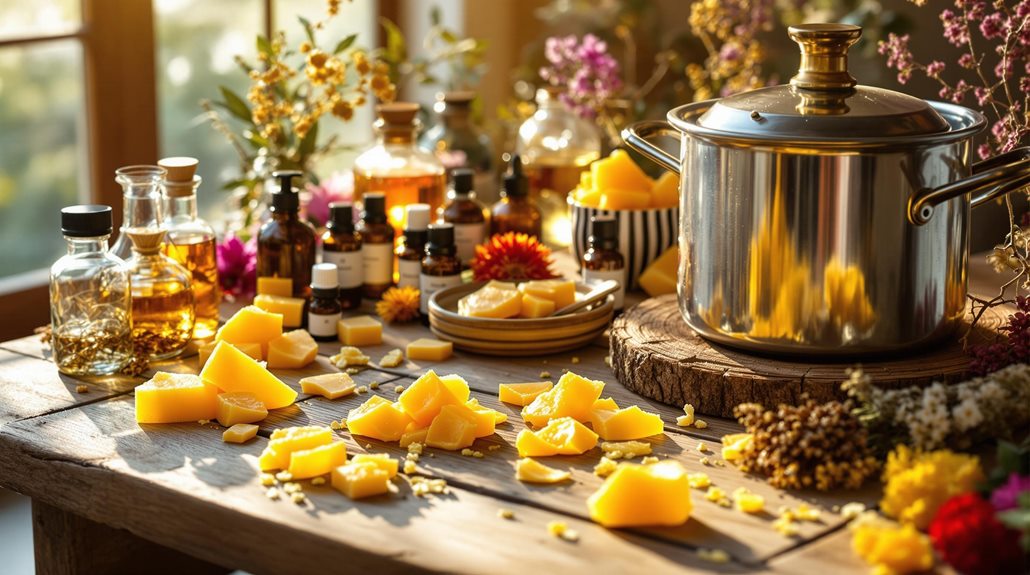
Three key qualities make beeswax essential for natural perfume making: it stabilizes scents, provides structure, and creates a smooth texture. When you're crafting solid perfume, beeswax serves as the foundation that holds your fragrant oils together. You'll need to melt it carefully using a double boiler method, keeping the temperature between 144-147°F to guarantee even melting.
Don't put together your perfume mixture until you've properly prepared your beeswax. Start by grating or chopping it into small pieces to facilitate even melting. Once melted, you'll combine it with your carrier oils and essential oil blends. The standard ratio is 1 part beeswax to 3 parts carrier oil, but you can adjust this depending on your desired firmness.
You don't need to worry about preservation as much with beeswax-based perfumes - they naturally resist bacterial growth. While it's hard work to get the consistency just right, the end result is worth the effort. Pour your mixture into small tins or containers while it's still liquid, and let it cool completely before use. Your solid perfume will remain stable at room temperature and last for several months.
Proper Storage Techniques
Proper storage can make or break your natural perfume's longevity and fragrance quality. Whether you're working with pure alcohol-based formulations or solid perfumes, protecting your creations from environmental factors is indispensable. Store your perfumes in dark amber or cobalt blue glass bottles, as these shield against harmful light exposure that can degrade your fragrances.
For perfumer's alcohol-based blends, ensure bottles have tight-fitting caps to prevent evaporation and oxidation. If you use drops of essential oils in solid perfumes, store them in the refrigerator to maintain their integrity. Keep all perfumes away from your bathroom, as humidity can compromise the formula. Check your stored perfumes regularly for any signs of separation or discoloration. Consider freezing solid perfumes if you won't use them within a few months.
Remember to label your bottles with the creation date and ingredients list. By following these storage guidelines, you'll extend the life of your natural perfumes and maintain their intended scent profiles. If you notice any unusual changes in color or smell, it's best to discard the perfume and start fresh.
Blending Different Scent Families
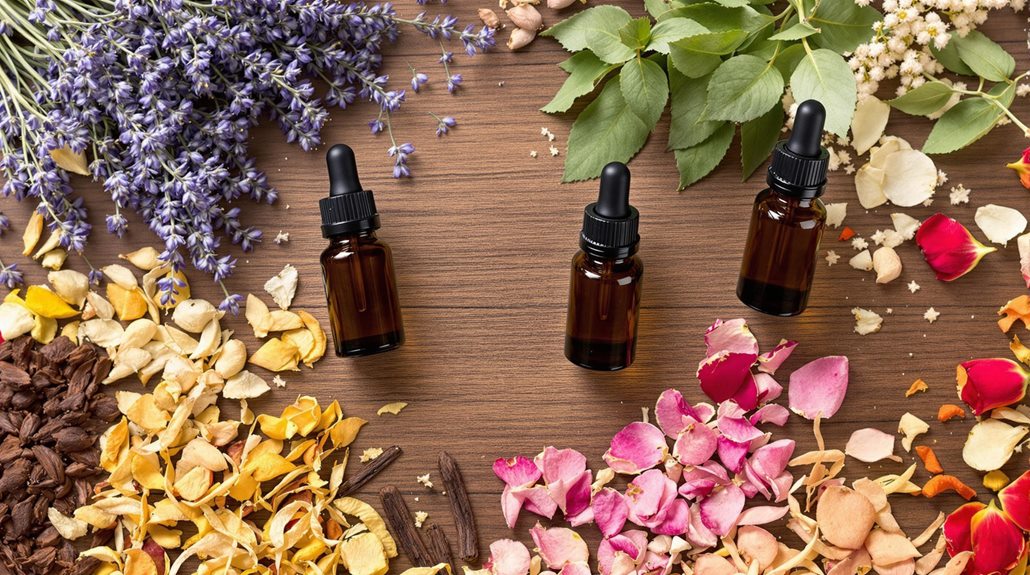
Commanding the art of blending scent families opens up endless possibilities for creating distinctive natural perfumes. When learning how to make your own eau de parfum, you'll want to experiment with combining different scent categories while maintaining balance and harmony. Never use random combinations without understanding how they interact - instead, start by pairing complementary families like florals with woods or citrus with earthy notes.
While many online perfumery courses teach traditional combinations, don't be afraid to try unexpected pairings. For example, you might uncover that patchouli's deep earthiness perfectly complements bright citrus top notes. As you blend, pay careful attention to how the scents evolve together over time, considering the interplay between your top, middle, and base notes.
Keep a detailed journal of your blending experiments, noting which combinations work well and which don't. Document the proportions you've used and how the fragrances develop. This record-keeping is essential for recreating successful formulas and refining your technique. Focus particularly on how materials from the same family, like different floral notes, interact with each other to create depth and complexity in your final creation.
Common Mistakes to Avoid
While perfecting scent combinations takes practice, being aware of common pitfalls can save you time and precious ingredients in your natural perfumery expedition. As you learn how to make your own fragrances, I've found that beginners often encounter several preventable mistakes.
- Using too much essential oil at once - start with tiny drops, as you can always add more, but you can't take it away once it's mixed
- Not keeping detailed notes - if you're not sure about your measurements or combinations, you won't be able to replicate successful blends
- Rushing the aging process - natural perfumes need time to mature and develop their full character, typically 4-6 weeks
- Skipping proper dilution - essential oils are highly concentrated and can cause skin irritation if not properly diluted in a carrier oil
- Using plastic containers - essential oils can degrade plastic over time; always use dark glass bottles for storage and blending
Conclusion
You're now equipped to start creating unique natural perfumes in your own home. Remember to experiment with different essential oils, take detailed notes of your combinations, and be patient as you develop your signature scents. Don't rush the process - perfumery is an art that takes practice. With proper storage and careful attention to proportions, you'll soon be crafting beautiful, natural fragrances that rival commercial options.

